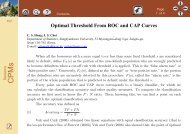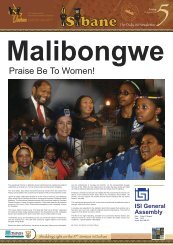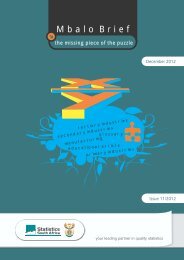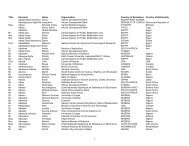General household survey - Statistics South Africa
General household survey - Statistics South Africa
General household survey - Statistics South Africa
You also want an ePaper? Increase the reach of your titles
YUMPU automatically turns print PDFs into web optimized ePapers that Google loves.
<strong>Statistics</strong> <strong>South</strong> <strong>Africa</strong> 47<br />
P0318<br />
Step 5: Generate an integer random number r between 1 and R , and compute<br />
n r r r<br />
integers 1,<br />
2,<br />
− − −,<br />
n as follows:<br />
r = r<br />
.<br />
.<br />
.<br />
.<br />
1<br />
r = r + R<br />
r<br />
2<br />
3<br />
1<br />
r = r + R<br />
2<br />
r = r<br />
i<br />
n<br />
= r<br />
( i−1)<br />
+ R<br />
( n−1)<br />
+ R.<br />
Step 6: Select n PSUs out of the N PSUs in the stratum with the labels (sequence numbers)<br />
number<br />
n i i i ., . . , , 1 2 such that:<br />
C<br />
C<br />
.<br />
.<br />
C<br />
i1<br />
−1<br />
i2<br />
−1<br />
in<br />
−1<br />
18.8 Weighting 11<br />
< r ≤ C<br />
1<br />
2<br />
n<br />
i1<br />
< r ≤ C<br />
i2<br />
< r ≤ C .<br />
in<br />
Then, the n PSUs with the labels<br />
n i i i ., . . , , 1 2 would get selected with probabilities proportional to size,<br />
and the selection probability of the PSU i will be given by R .<br />
The sampling weights for the data collected from the sampled <strong>household</strong>s were constructed so that the<br />
responses could be properly expanded to represent the entire civilian population of <strong>South</strong> <strong>Africa</strong>. The<br />
design weights, which are the inverse sampling rate (ISR) for the province, are assigned to each of the<br />
<strong>household</strong>s in a province.<br />
Mid-year population estimates produced by the Demographic Analysis division were used for<br />
benchmarking. The final <strong>survey</strong> weights were constructed using regression estimation to calibrate to<br />
national level population estimates cross-classified by 5-year age groups, gender and race, and provincial<br />
population estimates by broad age groups. The 5-year age groups are: 0–4, 5–9, 10–14, 55–59, 60–64;<br />
and 65 and over. The provincial level age groups are 0–14, 15–34, 35–64; and 65 years and over. The<br />
calibrated weights were constructed such that all persons in a <strong>household</strong> would have the same final weight.<br />
The <strong>Statistics</strong> Canada software StatMx was used for constructing calibration weights. The population<br />
controls at national and provincial level were used for the cells defined by cross-classification of Age by<br />
Gender by Race. Records for which the age, population group or sex had item non-response could not be<br />
weighted and were therefore excluded from the dataset. No additional imputation was done to retain these<br />
records.<br />
Household estimates that were developed using the UN headship ratio methodology were used to weight<br />
<strong>household</strong> files. The databases of Census 1996, Census 2001, Community Survey 2007 and the Labour<br />
Force Survey 2003, Labour Force Survey 2005, and Quarterly Labour Force Survey (quarter 3) of 2009<br />
were used to analyse trends and develop models to predict the number of <strong>household</strong>s for each year. The<br />
11 Source: Sampling and Weighting System for the Redesigned <strong>South</strong> <strong>Africa</strong>n Labour Force Survey, by G. Hussain Choudhry, 2007.<br />
R i<br />
<strong>General</strong> Household Survey, July 2011















